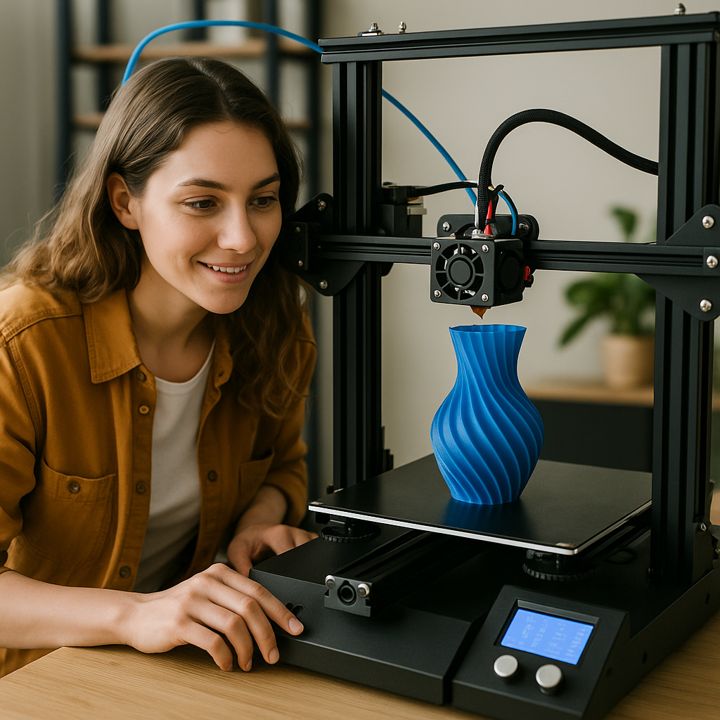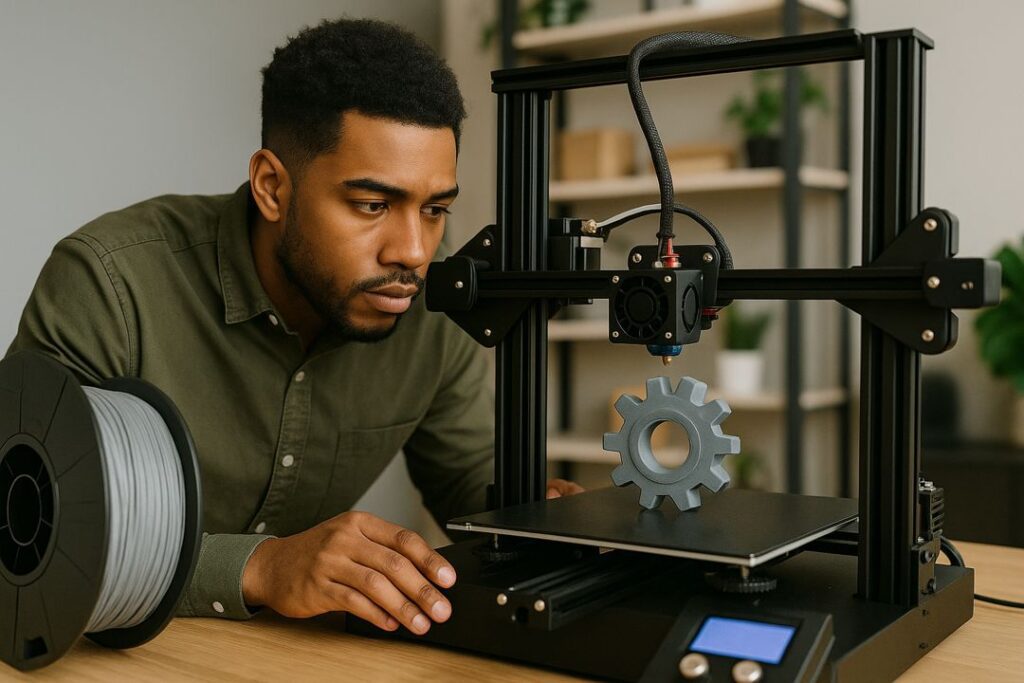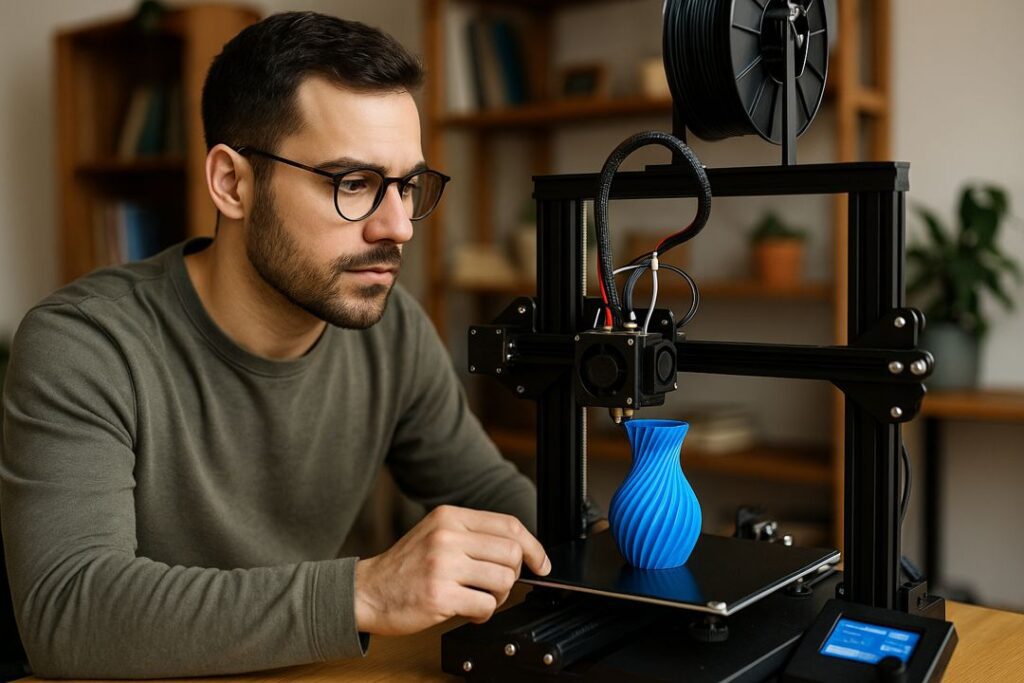Sell 3D-Printed Goods from Home: How to Create, Price, and Ship Custom 3D Art and Utility Items
🚀 Introduction: Turning Your Hobby into a Profitable Business
Imagine sitting at your kitchen table, sipping coffee, while a small machine in the corner is quietly producing unique, in-demand products that you’ll sell for a profit later today.
That’s the reality of selling 3D-printed goods from home.
Once the domain of tech hobbyists, 3D printing has exploded into mainstream use—and with it, an entirely new set of income opportunities has emerged.
You don’t need a massive workshop. You don’t need a degree in engineering. And you definitely don’t need to quit your day job (yet). All you need is a quality 3D printer, some creative ideas, and a willingness to learn.
By the end of this guide, you’ll know:
✅ How to choose the right printer and materials
✅ What products sell best (and why)
✅ How to price for profit
✅ Where to sell and how to ship efficiently
✅ How to market your products so they stand out in a crowded market

💡 Why 3D Printing is the Perfect Home-Based Business
The appeal of 3D printing as a business comes down to three things: low start-up costs, high customization, and massive niche potential.
1. Low Overhead
Once you’ve invested in your printer and materials, your main expenses are filament, electricity, and packaging. No rent. No inventory storage costs. No massive upfront orders.
2. Customization = Premium Pricing
In a world of mass-produced, identical products, customization is king. Customers are willing to pay extra for items that are designed just for them—whether that’s a name engraved in a gadget holder or a one-of-a-kind home décor piece.
3. Niche Potential Everywhere
From tabletop gamers to pet lovers to home-organization fanatics, there’s a corner of the market that’s ready for your creations. Your job? Find them, and give them something they can’t get anywhere else.
🛠 Choosing the Right 3D Printer
Your printer is the beating heart of your operation. Choose wisely.
Recommended Model:
Creality Ender 3 V2 – Affordable, reliable, beginner-friendly, and produces professional-grade prints without breaking the bank.
When selecting your machine, think about:
- Build Volume: Bigger printers mean you can create larger items, but they also take up more space.
- Resolution Quality: Higher resolution = smoother surfaces, less sanding and finishing.
- Material Compatibility: PLA is a great starter filament, but if you want flexible or heat-resistant products, you’ll want a printer that handles ABS, PETG, or TPU.
- Maintenance & Upgrades: Some models are easy to modify or repair, extending their lifespan and capabilities.
💡 Pro Tip: Don’t go for the cheapest no-name printer online. Saving $100 now could cost you weeks of frustration later.
🎯 Finding Products That Sell
The most profitable items are useful, unique, or personal. That’s where you’ll stand out.
Popular & Profitable Niches:
- Home Décor: Modern planters, geometric wall art, custom lampshades.
- Kitchen Tools: Custom cookie cutters, measuring scoops, utensil holders.
- Tech Accessories: Phone stands, cable organizers, gaming controller mounts.
- Pet Products: Personalized ID tags, treat dispensers, custom feeders.
- Gaming Add-Ons: Miniatures, dice towers, card holders.
- Replacement Parts: For discontinued items—everything from appliance knobs to furniture fittings.
- Jewelry & Fashion: Statement earrings, custom belt buckles, watch stands.
- Organizers: Drawer inserts, desktop sorters, closet accessories.
💡 Pro Tip: Spend 30 minutes on Etsy or TikTok searching “3D printed” to spot trending products you can put your own spin on.

✏️ Designing Your Products
Sure, you can download free models from sites like Thingiverse or Cults3D, but the real money is in custom or original designs.
Design Tools to Learn:
- Tinkercad – Beginner-friendly, perfect for simple projects.
- Fusion 360 – Professional tool for precision designs and mechanical parts.
- Blender – Best for organic shapes and artistic projects.
You don’t need to be a CAD wizard from day one. Start with simple modifications to existing models: change dimensions, add personalization, or merge designs into something new.
💲 How to Price for Profit
Pricing 3D-printed products isn’t about competing with the cheapest sellers—it’s about value and uniqueness.
Here’s what to factor in:
- Material Costs: Filament, resin, or specialty materials.
- Print Time: Long prints tie up your machine. Your time has value.
- Post-Processing: Sanding, painting, or assembling.
- Packaging & Shipping: Supplies and postage.
- Marketplace Fees: Etsy, eBay, or payment processor cuts.
Example:
If it costs you $4 in materials, takes 1.5 hours of printing, and 20 minutes of finishing, and you value your time at $20/hour, your cost might be around $15. Double or triple that for retail pricing—especially for personalized or hard-to-find items.
🌐 Where to Sell Your Creations
You have more options than you think:
- Etsy: A powerhouse for custom and handmade goods.
- eBay: Ideal for niche replacement parts and collectibles.
- Your Own Website: Full control over branding and profits.
- Local Craft Markets: Great for building community presence.
- Social Media Shops: Facebook Marketplace, Instagram Shopping, TikTok Shop.
- B2B Sales: Small businesses needing branded items or display stands.
💡 Pro Tip: Start on a marketplace to get early traction. Once you have repeat customers, guide them to your own website where you keep more profit.
📣 Marketing That Works
If your amazing product sits unseen, it won’t sell. Your marketing should make people feel they must have what you make.
Ideas to Try:
- TikTok/Instagram Reels: Show the print process in time-lapse—it’s oddly satisfying.
- Pinterest Boards: Great for décor and lifestyle niches.
- Behind-the-Scenes Content: People love seeing your setup and process.
- Email List: Offer discounts or early access to new designs.
- User-Generated Content: Send freebies to influencers in exchange for honest reviews.
👉 Want to turn your 3D printing hobby into a full-blown online store? Learn how to set up and market your business with Wealthy Affiliate and get the training you need to grow.
📦 Packaging & Shipping Like a Pro
Your customer’s first in-person interaction with your brand is your packaging—make it memorable.
- Protect Fragile Items: Bubble wrap or paper padding.
- Add a Personal Touch: A thank-you note or discount code for their next order.
- Brand It: Stickers, labels, or even custom tape.
- Ship Smart: Compare USPS, UPS, and FedEx for the best rates.

📈 Scaling Your 3D Printing Business
Once you’ve mastered the basics, growth comes from automation and diversification.
- Batch Printing: Run multiples of your best-sellers overnight.
- Upgrade Equipment: Larger or faster printers, resin printers for higher detail.
- Offer Custom Orders: People will pay top dollar for “one-off” creations.
- Expand Product Lines: Add seasonal items, bundles, or accessories.
❓ FAQ
Q: How much do I need to invest to start?
A: You can start for under $500 with a solid printer and basic supplies.
Q: Is 3D printing environmentally friendly?
A: PLA filament is plant-based and biodegradable, making it a greener option.
Q: What if I’m not good at design?
A: Start with existing models, customize them, and gradually learn to design from scratch.
🏁 Final Thoughts
Selling 3D-printed goods from home is the perfect blend of creativity and entrepreneurship. You can start small, test ideas, and scale as you grow. The demand for personalized, custom, and practical items isn’t going anywhere—and you can be the person who fills that need.
So fire up that printer, start experimenting, and turn your hobby into a money-making machine. The only thing left? Take action today. 💪

Larry Mac
Hi there, and thanks for stopping by! My name is Larry, and I’m the voice behind 6fig.com. I search the Internet to try and find Money making opportunities to share.. Thank you for stopping by, Feel free to subscribe and comment. Thank You!
When you’re ready to build a real income stream around your digital product brand, join me at Wealthy Affiliate and learn how to build a business that works while you sleep.


